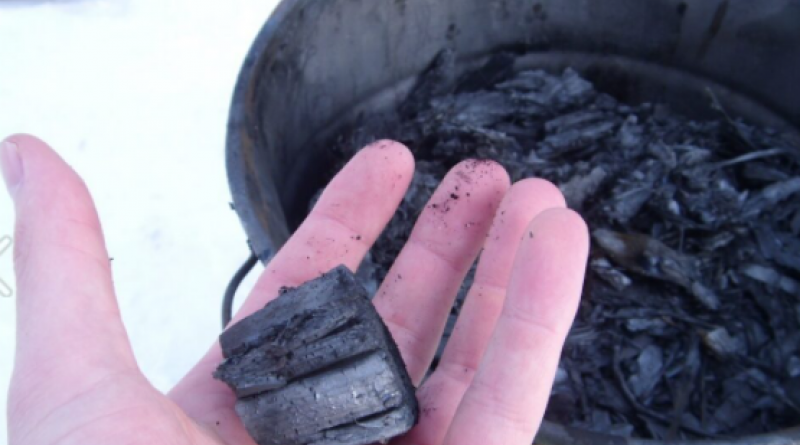Biochar can help us keep climate change at bay and more food on the table, according to a new meta-study

I’m always down with more food and fewer heatwaves.
Biochar — organic material baked in oxygen-starved environments — can help power up the agriculture industry while also fighting against climate change, according to a new paper.
Coal is naturally produced underground, over millions of years, from ancient biomass. This organic matter that got buried in some way or another was then compressed and heated up through geological processes, which broke down its original structure and increased its carbon content. Biochar is produced in a very similar way, but instead of letting natural (and slow) geological processes cook it up, we make it ourselves.
This material can help fertilize soils and, thus, increase crop yields. At the same time, by preventing the carbon within it from being released back into the atmosphere, the use of biochar in agriculture can help fight climate change.
Very, very, very well done
“Biochar can draw down carbon from the atmosphere into the soil and store it for hundreds to thousands of years,” says Stephen Joseph, lead author of the paper, and a Visiting Professor in the School of Materials Science and Engineering at the University of New South Wales Science. “This study also found that biochar helps build organic carbon in soil by up to 20 percent (average 3.8 percent) and can reduce nitrous oxide emissions from the soil by 12 to 50 percent, which increases the climate change mitigation benefits of biochar.”
Biochar is a product usually made from aggregated organic waste — a mixture of waste biomass from agriculture, forestry, and household sources. For such an unassuming substance, it could lend a sizable hand towards fighting climate change and us having more food, according to a new paper. The findings are supported by the Intergovernmental Panel on Climate Change’s recent Special Report on Climate Change and Land, which estimated there was important climate change mitigation potential available through biochar. This report estimated that biochar use “could mitigate between 300 million and 660 million tons of carbon dioxide [globally] per year by 2050,” Prof. Joseph explains.
“Compare that to Australia’s emissions last year—an estimated 499 million tons of carbon dioxide—and you can see that biochar can absorb a lot of emissions. We just need a will to develop and use it.”
The meta-study reviewed 300 papers on the topic, including 33 meta-analyses that together reviewed around 14,000 biochar studies that have been published over the last 20 years. According to its result, the use of biochar, when mixed-in with crop soils, can boost yields by 10% to 42%, reduce the levels of heavy metals in plant tissues by between 17% and 39%, and increases the bioavailability of phosphorus, a critical nutrient that often acts as a bottleneck for the development of plants.
All in all, its use helps plants grow faster and larger, while also helping them better resist environmental stresses such as toxic metals, diseases, organic stressors such as herbicides and pesticides, and water stress.
The paper also explains how biochar acts on the roots of plants, boosting them. In the first three weeks of a plant’s life, it explains, biochar particles react with soils and stimulate germination (i.e. it helps seeds ‘catch’) and the development of the fledgling plant. Over the next six months or so, biochar particles in the soil form reactive surfaces which help draw nutrients towards the roots. As these particles start to age, something that happens around three to six weeks after being mixed into the soil (depending on environmental conditions), they break down and form microaggregates with other chemicals. This, in turn, helps protect roots and prevents the decomposition of organic matter.
Biochar yielded the best effects when used in acidic or sandy soils together with fertilizers, the authors explain.
“We found the positive effects of biochar were dose-dependent and also dependent on matching the properties of the biochar to soil constraints and plant nutrient requirements,” Prof. Joseph says.”Plants, particularly in low-nutrient, acidic soils common in the tropics and humid subtropics, such as the north coast of NSW and Queensland, could significantly benefit from biochar.”
“Sandy soils in Western Australia, Victoria and South Australia, particularly in dryland regions increasingly affected by drought under climate change, would also greatly benefit.”
Prof. Joseph has been studying the use of biochar ever since he was introduced to the practice by Indigenous Australians in the seventies. He explains that these people, alongside indigenous groups in Australia, Latin America (especially in the Amazon basin), and Africa, have been using biochar to maintain soil health and improve crops for centuries. Despite this, it hasn’t really been adopted as a commercial product, and most countries only produce a small amount of biochar every year.
To really make an impact, he explains, biochar needs to be integrated with farming operations on a wide scale. The first step towards that, he feels, is to tell farmers that biochar is an alternative they can opt for, and establish demonstrations so farmers can see that the benefits are real, not just words.
“This is in part due to the small number of large-scale demonstration programs that have been funded, as well as farmers’ and government advisors’ lack of knowledge about biochar, regulatory hurdles, and lack of venture capital and young entrepreneurs to fund and build biochar businesses,” he explains. “We’ve done the science, what we don’t have is enough resources to educate and train people, to establish demonstrations so farmers can see the benefits of using biochar, to develop this new industry”.
The paper “How biochar works, and when it doesn’t: A review of mechanisms controlling soil and plant responses to biochar” has been published in the journal GCB Bioenergy.
August 2021
zme science




